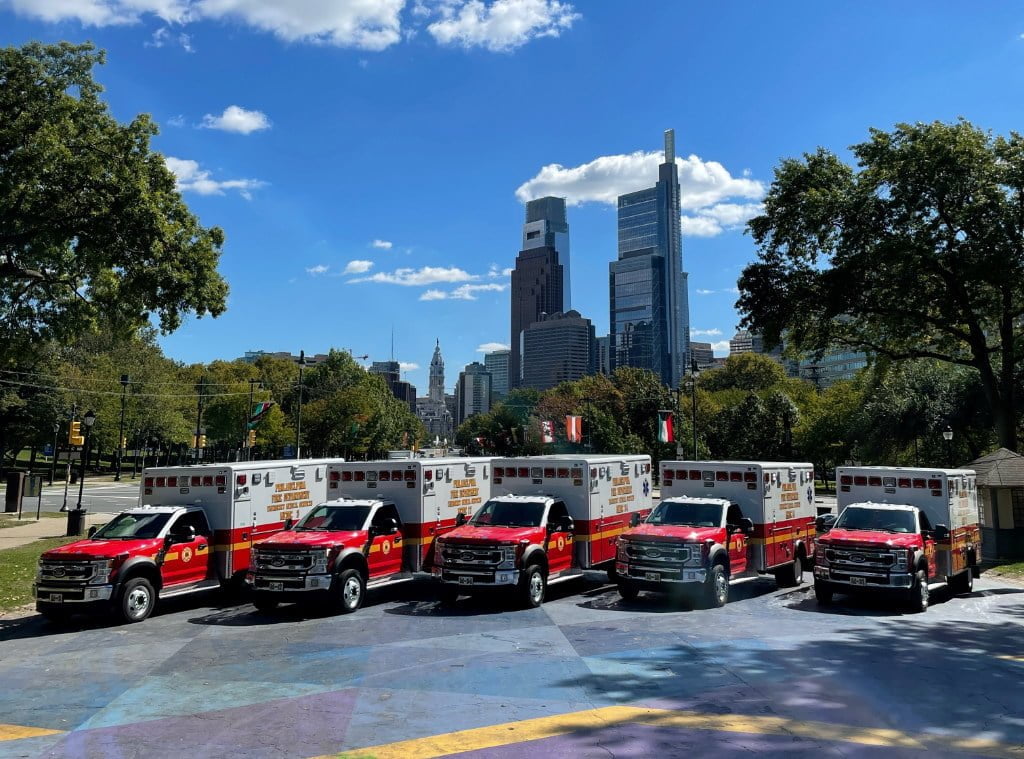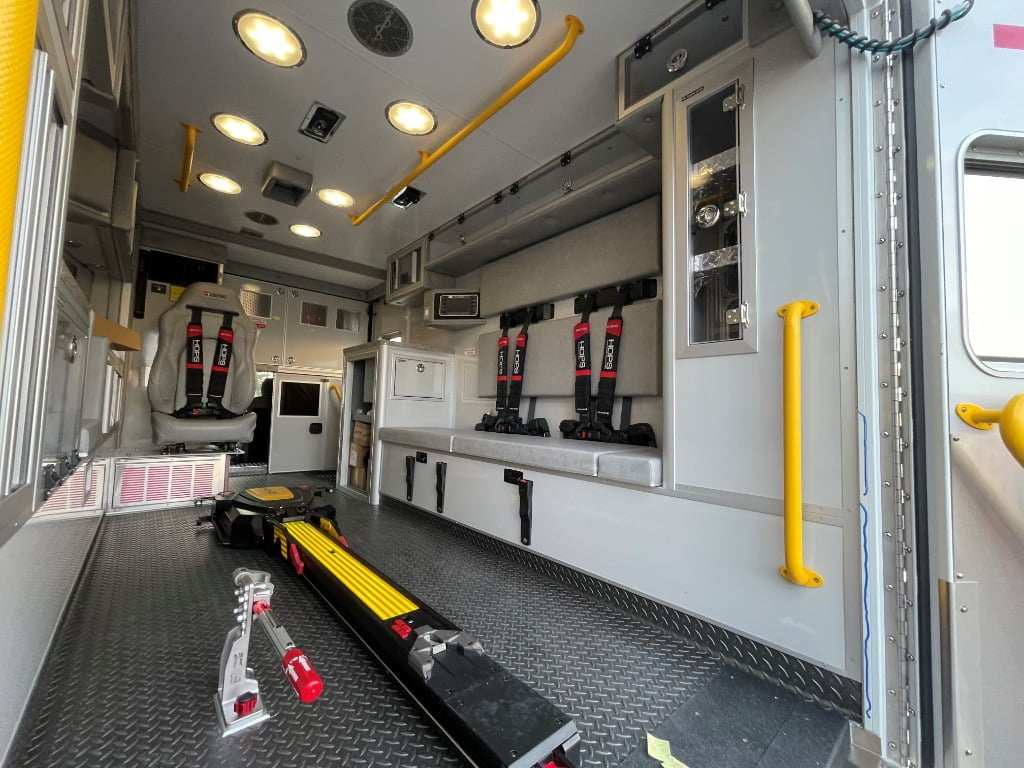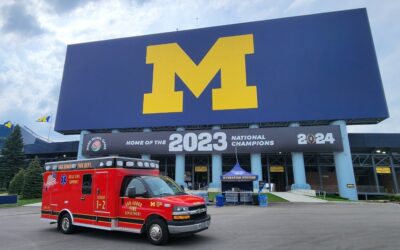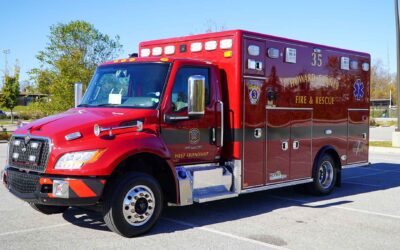
Philadelphia (PA) Fire Department recently received the last three Type 1 ambulances of a 13-rig order from Horton Emergency Vehicles. (Photos courtesy of Philadelphia Fire Department.)
By Alan M. Petrillo
Philadelphia (PA) Fire Department has received three more Type 1 ambulances from Horton Emergency Vehicles, the last of a 13-rig contract, but with shorter bodies in order for them to fit in firehouses with apparatus bay length restrictions.
Martin McCall, the department’s assistant deputy commissioner for EMS, points out that the ambulance spec that Philadelphia developed “is pretty unique for use in our city, with a body 167-inches long. But in the case of these last three units, we trimmed the body down to 159-inches because they have to fit in three firehouses where the apparatus bay space is limited.”

The most-recent three Horton ambulances Philadelphia received have bodies reduced to 159 inches long to enable them to fit in apparatus bays with length restrictions.
Bob Bohony, owner of VCI Emergency Vehicle Specialists, who sold the ambulances to Philadelphia, says retooling the bodies required a joint effort of VCI, Horton and the fire department. “It involved talking closely with commissioner McCall and Lt. Chris Wynne about moving some equipment, and the storage capacities that would be impacted by those moves,” Bohony notes. “These ambulances are the culmination of 25 years of design collaboration among the parties, and over the years we’ve evolved to a design that serves Philadelphia best.”
Dave Marshall, Horton’s director of sales, says the Philadelphia rigs are built on Ford F-550 four-wheel-drive chassis and two-door cabs with a 18,000-pound GVWR (gross vehicle weight rating) and a Liquid Spring rear axle, powered by a 6.7-liter engine. Marshall notes that the ambulances have the Cool-Tech® II HVAC (heating, ventilating and air conditioning) system that intuitively monitors pressure inside the system and turns on only the number of fans to efficiently cool, alternating fans each time so they are used as evenly as possible. The Philadelphia rigs also incorporate solar panels on the roof to trickle charge the vehicles’ batteries.
Related
Boone County (WV) Ambulance Authority Gets Wheeled Coach Critical Care Transport Ambulance
Pasco County (FL) Fire Rescue Goes to Road Rescue for Larger Cab Type 1 Ambulance
North Andover (MA) Fire Department Adds Horton Type 1 Ambulance to Its Fleet
Wynne notes that the new Horton ambulances have the Horton 360™ camera system that delivers 360-degree views of the ambulance’s surroundings. “Safety of our crews, patients and bystanders is of utmost importance,” Wynne says, “and this system gives us video aerial views of the road and the scene.”

The Horton ambulances have a USSC Valor attendant seat that incorporates a child safety seat, two squad bench seat positions, and a CPR seat, all protected by Per4max four-point harnesses.
McCall adds that the new ambulances also have the HOPS™ (Horton Occupant Protection System) that incorporates an IMMI rollover air bag system in the module, with progressive foam at head-strike points to absorb energy upon impact. The CPR seat, the two seats on the squad bench and the USSC Valor attendant’s seat that incorporates a child safety seat, all are protected by Peer4max four-point seat belt harnesses, that feature automatic retractors and decelerators, he notes.
An unusual feature on the rigs is a back bumper designed for a quick change-out, McCall says. “Because back bumpers are damaged often, we have Horton put a notch in the body that allows the bumper to be shoved under the truck if it is struck hard enough,” McCall points out. “The bumper is held by two truck-style pin hinges, so that it can be removed and replaced pretty quickly by our shop.” Another feature on these three rigs, he says, is the addition of EchoVision backup alarms where the beeping gets louder and shriller as the vehicle approaches an obstacle, and a lighting panel in the cab flashes from green to yellow to red.

Philadelphia’s ambulances use the Stryker PowerLOAD system and Power-PRO cots.
Philadelphia added additional lights to exterior compartment doors that are visible to oncoming traffic when the doors are open, an electronic key system of the narcotics safe inside the module, and an Activek Health Solutions enhanced hydrogen peroxide unit to kill bacteria and viruses inside the box. Philadelphia continued its use of Stryker PowerLOAD and Power-PRO Cots in the most recent three vehicles.
ALAN M. PETRILLO is a Tucson, Ariz.-based journalist, the author of three novels and five non-fiction books, and a member of the Fire Apparatus & Emergency Equipment editorial advisory board. He served 22 years with Verdoy (NY) Fire Department, including the position of chief.




